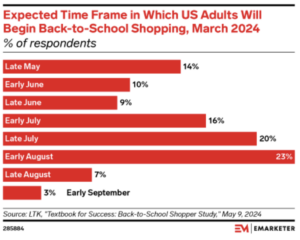Back-to-School Retention Strategies for 2024

The back-to-school season has become a cornerstone revenue driver for retailers, with US sales expected to grow 3.2% to $81.16 billion this year. Understanding key factors influencing consumer behavior — such as promotional preferences, the impact of other summer sales events like Prime Day and State Sales Tax Holidays, and the balance between in-store and online shopping — is crucial for retailers preparing their back-to-school marketing strategies.
Crafting a Multi-Channel Strategy
Retailers need to develop a marketing strategy that not only reaches new customers, but also nurtures and retains their existing ones. Using a multi-channel approach across all of the below retention channels helps create consistency and recall for both new and existing customers.
1. Identify Key Back-to-School Shopping Dates
Pinpointing key shopping dates during the back-to-school season can help your brand determine the best times to run promotions and stay competitive.
How to Implement:
- Amazon Prime Day occurs over two days every July (the 16th and 17th this year) presents an opportunity to run competing promotions to attract discount shoppers.
- Many states have sales tax holidays, often in the summer, which can drive in-store purchasing. Align your promotions with these dates to maximize sales.
- Keep consumers updated on these sales dates through geo targeted and regional text email banners, SMS, and App pushes.
2. Showcase Product Features and Benefits
By showcasing unique product features and qualities you can directly address specific customer needs and differentiate your brand from competitors.
How to Implement:
- Highlight features like durability and fabric quality to address concerns about product quality to parents.
- Highlight the adaptability and inclusiveness of your products by showcasing any easy-on, easy off, sensory friendly, or adjustable features.
Real World Example:
Create MMS, App, and Email campaigns focused on product adaptability, highlighting features like easy-on/easy-off, sensory-friendly, and adjustable options. Show how these features simplify school routines for busy parents and promote inclusivity.
- Use a gif in MMS or App push to showcase gender, age and adaptability of product offering
- In emails use clear icons and an organized layout to effectively communicate these key attributes, educating customers on the versatility and inclusiveness of your products.
3. Highlight Outfitting and “One-Stop-Shop” Options
Demonstrating the versatility and range of your products will position your brand as a “one-stop-shop,” save customers time, and increase their average order value.
How to Implement:
- Simplify the shopping experience by showcasing complete outfit solutions that mix and match key products. This approach helps parents easily visualize and purchase coordinated looks.
- Present cohesive product bundles that include shoes, accessories, and other seasonal items to position your brand as a “one-stop-shop” and encourage larger purchases.
Real World Example:
Create an email campaign focused on how your products can be used from day to night for students. Organize the email layout by time blocks reflecting a typical day, including school drop-off, after-school activities, and winding down at home.
4. Include Flexible Payment Options
Offering flexible payment methods increases purchasing options, reduces friction, and caters to diverse customer financial preferences.
How to Implement:
- Remind customers of your flexible payment options like Buy Now Pay Later plans, cash-back programs, and free shipping thresholds. This makes purchases more convenient and financially manageable for budget-conscious consumers.
- Include linked payment options such as Apple Pay, Google Pay, PayPal, or saved credit card information to streamline the checkout process and reduce friction.
5. Add Value with Guides and Quizzes
Providing consumers with educational content about your products drives purchases and increases customer satisfaction by helping them find the right products for their needs.
How to Implement:
- Provide educational resources like fit guides (which are sizing charts or plugins like True Fit) and personalized recommendations through interactive quizzes.
- Create back-to-school shopping guides and quizzes suggesting products based on age, school year, and personal preferences.
- Incorporate size/fit guides and interactive quizzes in all email communications to ensure customers always have access to them.
6. Leverage Loyalty Programs
Loyalty programs incentivize repeat purchases and customer engagement by offering exclusive perks and discounts. These strategies help foster long-term relationships and increase customer lifetime value.
How to Implement:
- Reward loyalty members with double points on school-related purchases, early access to sales, or special point redemption periods.
- Implement tiered levels based on back-to-school spending where higher tiers unlock perks like exclusive discounts or priority access to sales events.
Real World Example:
Create a “join now and earn” loyalty program incentive for new members. Use app notifications, email campaigns, and SMS/MMS marketing to promote this campaign across channels and attract new loyalty members.
7. Offer an Omni-Channel Experience
While we live in a highly digital world, 65.1% of consumers still plan to do back-to-school shopping in-person, enforcing the need for retailers to offer a seamless and convenient shopping experience across both online and offline channels.
How to Implement:
- Use online channels to promote in-store offerings by incorporating geo-targeted email banners, SMS/MMS, and app notifications that specify the closest brick and mortar locations to recipients.
- Offer services like free ship-to-store, same-day delivery, in-store pickup, or curbside pickup options caters to hybrid customers.
Preparing Your Brand For Back to School
As the back-to-school season approaches, retailers must adapt their marketing strategies to meet the evolving needs and preferences of consumers. By leveraging a mix of retention channels, creating compelling content, and offering a seamless shopping experience, brands can effectively engage customers, foster loyalty and drive revenue growth. For personalized help in effectively implementing these strategies, get in touch.
